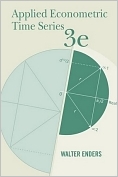| |||||
• polskie
• Zamów informacje o nowościach z wybranego tematu • kontakt |
APPLIED ECONOMETRIC TIMES SERIESENDERS W.wydawnictwo: WILEY, 2009, wydanie IIIcena netto: Enders continues to provide business professionals with an accessible introduction to time-series analysis. He clearly shows them how to develop models capable of forecasting, interpreting, and testing hypotheses concerning economic data using the latest techniques. The third edition includes new discussions on parameter instability and structural breaks as well as out-of-sample forecasting methods. New developments in unit root test and cointegration tests are covered. Multivariate GARCH models are also presented. In addition, several statistical examples have been updated with real-world data to help business professionals understand the relevance of the material. Table of Contents
PREFACE. ABOUT THE AUTHOR. Chapter DIFFERENCE EQUATIONS. 1 Time-Series Models. 2 Difference Equations and Their Solutions. 3 Solution by Iteration. 4 An Alternative Solution Methodology. 5 The Cobweb Model. 6 Solving Homogeneous Difference Equations. 7 Finding Particular Solutions for Deterministic Processes. 8 The Method of Undetermined Coefficients. 9 Lag Operators. Summary and Conclusions. Questions and Exercises. Endnotes. Appendix 1 Imaginary Roots and de Moivre’s Theorem. Appendix 2 Characteristic Roots in Higher-Order Equations. Chapter 2 STATIONARY TIME-SERIES MODELS. 1 Stochastic Difference Equation Models. 2 ARMA Models. 3 Stationarity. 4 Stationarity Restrictions for an ARMA(p, q) Model. 5 The Autocorrelation Function. 6 The Partial Autocorrelation Function. 7 Sample Autocorrelations of Stationary Series. 8 Box–Jenkins Model Selection. 9 Properties of Forecasts. 10 A Model of the Interest Rate Spread. 11 Seasonality. 12 Parameter Instability and Structural Change. Summary and Conclusions. Questions and Exercises. Endnotes. Appendix 1 Estimation of an MA(1) Process. Appendix 2 Model Selection Criteria. Chapter 3 MODELING VOLATILITY. 1 Economic Time Series The Stylized Facts. 2 ARCH Processes. 3 ARCH and GARCH Estimates of Inflation. 4 Two Examples of GARCH Models. 5 A GARCH Model of Risk. 6 The ARCH-M Model. 7 Additional Properties of GARCH Processes. 8 Maximum Likelihood Estimation of GARCH Models. 9 Other Models of Conditional Variance. 10 Estimating the NYSE International 100 Index. 11 Multivariate GARCH. Summary and Conclusions. Questions and Exercises. Endnotes. Appendix 1 Multivariate GARCH Models. Chapter 4 MODELS WITH TREND. 1 Deterministic and Stochastic Trends. 2 Removing the Trend. 3 Unit Roots and Regression Residuals. 4 The Monte Carlo Method. 5 Dickey–Fuller Tests. 6 Examples of the ADF Test. 7 Extensions of the Dickey-Fuller Test. 8 Structural Change. 9 Power and the Deterministic Regressors. 10 Tests with More Power. 11 Panel Unit Root Tests. 12 Trends and Univariate Decompositions. Summary and Conclusions. Questions and Exercises. Endnotes. Appendix 1 The Bootstrap. Chapter 5 MULTIEQUATION TIME-SERIES MODELS. 1 Intervention Analysis. 2 Transfer Function Models. 3 Estimating a Transfer Function. 4 Limits to Structural Multivariate Estimation. 5 Introduction to VAR Analysis. 6 Estimation and Identification. 7 The Impulse Response Function. 8 Testing Hypothesis. 9 Example of a Simple VAR Terrorism and Tourism in Spain. 10 Structural VARs. 11 Examples of Structural Decompositions. 12 The Blanchard and Quah Decomposition. 13 Decomposing Real and Nominal Exchange Rate Movements An Example. Summary and Conclusions. Questions and Exercises. Endnotes. Chapter 6 COINTEGRATION AND ERROR-CORRECTION MODELS. 1 Linear Combinations of Integrated Variables. 2 Cointegration and Common Trends. 3 Cointegration and Error Correction. 4 Testing for Cointegration The Engle–Granger Methodology. 5 Illustrating the Engle-Granger Methodology. 6 Cointegration and Purchasing-Power Parity. 7 Characteristic Roots, Rank, and Cointegration. 8 Hypothesis Testing. 9 Illustrating the Johansen Methodology. 10 Error-Correction and ADL Tests. 11 Comparing the Three Methods. Summary and Conclusions. Questions and Exercises. Endnotes. Appendix 1 Characteristic Roots Stability and Rank. Appendix 2 Inference on a Cointegrating Vector. Chapter 7 NONLINEAR TIME-SERIES MODELS. 1 Linear Versus Nonlinear Adjustment. 2 Simple Extensions of the ARMA Model. 3 Regime Switching Models. 4 Testing For Nonlinearity. 5 Estimates of Regime Switching Models. 6 Generalized Impulse Responses and Forecasting. 7 Unit Roots and Nonlinearity. Summary and Conclusions. Questions and Exercises. Endnotes. STATISTICAL TABLES. A. Empirical Cumulative Distributions of the ?. B. Empirical Distribution of ?. C. Critical Values for the Engle-Granger Cointegration Test. D. Residual Based Cointegration Test with I(1) and I(2) Variables. E. Empirical Distributions of the ?max and ?trace Statistics. F. Critical Values for ß1 = 0 in the Error-correction Model. G. Critical Values for Threshold Unit Roots. REFERENCES. SUBJECT INDEX. 517 pages, Hardcover Księgarnia nie działa. Nie odpowiadamy na pytania i nie realizujemy zamówien. Do odwolania !. |


